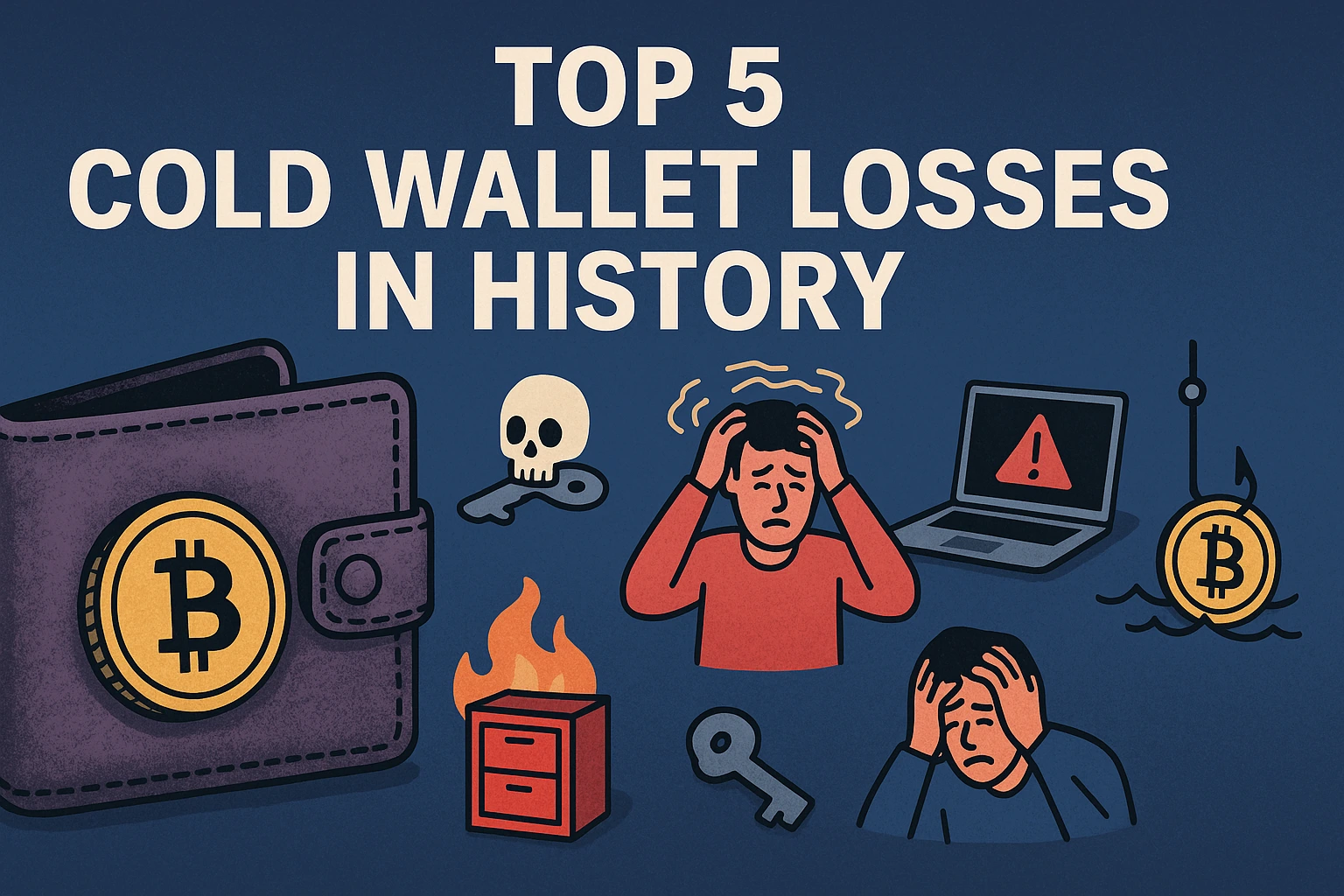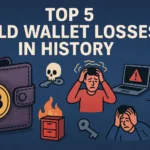The cryptocurrency ecosystem promises decentralization and ownership-but it also comes with a harsh reality: once access is lost, there’s no going back. Cold wallets, often praised for their security, have ironically been the graveyards of some of the largest cryptocurrency fortunes ever lost.
This article investigates five infamous cases where individuals, institutions, or entire exchanges lost access to staggering amounts of crypto held in cold wallets. From forgotten passwords to unexpected deaths and regulatory blackouts, these stories serve as cautionary tales for crypto users worldwide.
What Are Cold Wallets and Why Are They Risky?
Cold wallets (also known as hardware or offline wallets) are physical devices or paper backups that store crypto keys offline, making them immune to online attacks. They’re ideal for long-term storage-but if access credentials or physical access are lost, so is the cryptocurrency.
Key Risks of Cold Wallets:
- No backup of seed phrases
- Loss or destruction of physical device
- Death of the wallet owner without a succession plan
- Malfunctioning hardware with no recovery option
- Lack of proper estate planning or legal documentation
Case #1: James Howells – The $500 Million Landfill
In 2013, James Howells, a British IT worker, accidentally threw away a hard drive containing 8,000 BTC.
Timeline:
- 2010: Earned 8,000 BTC through early mining
- 2013: Accidentally discarded the hard drive while cleaning
- 2021: BTC peak value = ~$500 million
Howells has since launched legal battles with his local council in Newport, UK, pleading for permission to excavate the landfill where the hard drive is believed to be buried.
“I know it’s there, I just need a chance to find it.” – James Howells
Why It Matters:
- Highlights the importance of secure storage and backup.
- Shows how a minor oversight can turn into a financial tragedy.
Case #2: Gerald Cotten – QuadrigaCX’s Frozen Fortune
In 2019, Gerald Cotten, founder of Canadian crypto exchange QuadrigaCX, reportedly died in India-taking with him the passwords to cold wallets holding over $190 million in crypto assets.
Summary:
| Item | Detail |
| Amount Lost | $190+ million in BTC, ETH, and other tokens |
| Cold Wallet Status | Inaccessible – keys known only to Cotten |
| Public Suspicion | Allegations of mismanagement and potential faked death |
| Legal Outcome | Exchange declared bankrupt; minimal recovery for users |
Lessons Learned:
- No single point of failure should exist in custodial operations.
- Cold wallet access should involve multi-signature (multisig) schemes.
- Regular auditing and transparency are essential for trust.
Case #3: Stefan Thomas – The $300 Million Forgotten Password
Stefan Thomas, a German-born programmer living in the U.S., famously forgot the password to his IronKey hardware wallet, which contains 7,002 BTC. At Bitcoin’s peak in 2021, this amount was worth over $300 million.
Key Details:
- Type of wallet: IronKey hardware wallet
- Security feature: Allows only 10 password attempts before self-destruction
- Attempts left: Only 2 remain
Thomas received the 7,002 BTC in 2011 as a payment for creating an educational video titled “What is Bitcoin?”. Over time, he forgot the password and lost the paper on which he had written it.
“I would just lay in bed and think about it: Then I’d go to the computer with some new strategy, and it wouldn’t work, and I’d be desperate again.” – Stefan Thomas, in an interview with The New York Times
Why This Matters:
This case is a chilling example of how personal responsibility in crypto can also be a vulnerability. Thomas has refused to use hacking services or third-party recovery attempts, preferring to wait until potential cryptographic breakthroughs (such as quantum computing) make recovery more feasible.
Broader Implications:
- IronKey’s irreversible encryption design makes it a double-edged sword.
- Not having a secure, accessible, and backed-up password manager or seed phrase storage system can cost fortunes.
- The psychological burden of such a loss can be immense-Thomas has stated he made peace with it only after years of regret and therapy.
Case #4: Mircea Popescu – Billionaire Bitcoin Maximalist Dies, Billions Lost
Mircea Popescu, a controversial Romanian entrepreneur and early Bitcoin maximalist, drowned in Costa Rica in 2021. He was reportedly holding over 1 million BTC across various cold wallets, which-if true-would represent tens of billions of dollars in lost crypto.
Who Was Popescu?
- One of the earliest adopters of Bitcoin
- Founder of the now-defunct MPEx exchange
- Known for radical libertarian and anti-regulation views
Popescu was secretive and anti-establishment. After his death, there was no evidence of any succession plan, and access to his cold wallets was lost. While the precise amount he held is debated, some insiders and researchers estimate it to be anywhere from 30,000 to 1,000,000 BTC, potentially rivaling Satoshi Nakamoto’s stash.
“The Bitcoin community may never fully grasp the scale of what was lost with Popescu’s death.” – Anonymous developer on Reddit
Why This Matters:
- Popescu’s hoarded coins were never circulated, limiting market liquidity.
- His death demonstrates the urgent need for estate planning in crypto.
- If the 1M BTC estimate is true, it means almost 5% of total Bitcoin supply is locked forever.
Case #5: Mt. Gox Trustee & the Lost Cold Storage Recovery
Although not a single-person loss, the story of Mt. Gox-once the world’s largest Bitcoin exchange-is a defining chapter in crypto history. The exchange collapsed in 2014, losing around 850,000 BTC, of which 200,000 BTC were later found in cold storage.
However, the recovery of even those 200,000 BTC took years of litigation, forensic accounting, and trustee oversight. The remaining 650,000 BTC are considered permanently lost, many of them likely stored in wallets that are inaccessible due to poor wallet management and data loss.
Breakdown:
| Year | Event |
| 2010–2014 | Mt. Gox operates as leading BTC exchange |
| Feb 2014 | Exchange collapses, files for bankruptcy |
| Mar 2014 | 200,000 BTC found in old-format cold wallets |
| 2015–2024 | Ongoing legal battles, compensation schemes |
| 2024 | Partial payments to creditors still underway |
What Went Wrong:
- Private keys to old wallet formats were lost or improperly managed
- Internal mismanagement and lack of infrastructure oversight
- Poor access control and backup protocols
“We knew the wallets were out there, but the paths to them were corrupted or lost entirely.” – Former Mt. Gox developer (anonymous)
Summary Table: The Five Biggest Cold Wallet Losses
| Case | Amount Lost (BTC) | Estimated Value (USD) | Recovery | Key Reason |
| James Howells | 8,000 | $500M | None | Hard drive discarded |
| Gerald Cotten | 26,000+ | $190M+ | None | Sudden death, no access |
| Stefan Thomas | 7,002 | $300M | No | Forgotten password |
| Mircea Popescu | Est. 30k–1M | $1–30B | None | Death, no succession plan |
| Mt. Gox | 650,000 | $19B+ | No | Mismanagement, lost access |
Lessons Learned: The High Cost of Poor Key Management
Across the five most iconic cases of crypto losses through inaccessible cold wallets, one theme repeats itself: the failure of secure and redundant private key management. Unlike banks or centralized services, blockchain does not provide a customer support line to recover assets. Here are the key takeaways:
1. You Are Your Own Bank – Act Accordingly
Holding your crypto in cold storage means complete autonomy. But with great power comes great responsibility. All the mentioned losses occurred not due to hacks, but due to poor backup hygiene or lack of succession planning.
2. Password ≠ Seed Phrase
While passwords can be reset in centralized systems, seed phrases cannot. Losing a 12- or 24-word recovery phrase is akin to throwing away millions – as seen with James Howells and Stefan Thomas.
3. Death Without a Plan = Locked Crypto Forever
Both Gerald Cotten and Mircea Popescu demonstrate how failing to create a legal inheritance mechanism for crypto assets can lead to permanent loss. Estate planning is crucial, especially as crypto wealth grows.
4. Trustless Systems Don’t Mean Careless Systems
Mt. Gox’s cold wallet fiasco and other large-scale institutional losses show that decentralized trustless environments still require rigorous internal procedures and checks.
Best Practices for Protecting Cold Wallets
To avoid becoming another cautionary tale, here’s what every crypto investor should do – whether you’re HODLing $100 or $100 million.
A. Use Multi-layer Security
| Layer | Tool | Description |
| 1 | Hardware Wallet | Trezor, Ledger, or Keystone for cold storage |
| 2 | Offline Seed Backup | Steel plates, fireproof storage |
| 3 | Redundancy | Duplicate seed stored in separate, secure locations |
| 4 | Shamir Backup | Split seed phrases across multiple parties or locations |
| 5 | 2FA and Physical Security | Biometric locks, safes, and vaults |
B. Practice Key Rotation
Regularly rotate private keys (every 1–2 years), especially for wallets with long-term holdings. Ensure this process is logged securely and access is tightly controlled.
C. Estate Planning for Crypto
- Create multi-signature wallets with trusted heirs or legal representatives.
- Store recovery instructions with legal entities like trust funds or crypto estate services.
- Use tools like Casa, Unchained Capital, or Vault12 for inheritance planning.
“In crypto, redundancy is not paranoia – it’s insurance.”
Psychological Toll of Losing Millions
Beyond the financial loss, individuals like Stefan Thomas and James Howells report years of mental anguish, sleepless nights, and even depression caused by their losses. A Harvard Business Review article found that crypto losses trigger the same trauma responses as severe grief or guilt.
Coping Mechanisms
- Therapy or peer support groups
- Financial coaching to restructure goals
- Transparency and acceptance over time
In Thomas’ case, accepting his loss led to a healthier life balance and new professional goals, even without recovering the BTC.
FAQ: Lost Crypto on Cold Wallets
Q: Is it possible to recover crypto from a lost cold wallet?
A: Generally, no. Without the seed phrase or private key, recovery is near-impossible. In rare cases, forensic recovery tools or hardware specialists might recover data, but success rates are low.
Q: Can quantum computing unlock lost wallets?
A: In theory, yes – quantum computers could one day brute-force elliptic curve cryptography. However, this is years away and might require breaking current algorithms, at which point new blockchains will likely migrate to quantum-safe protocols.
Q: How many BTC are considered “lost forever”?
A: Estimates vary, but as of 2025, roughly 3.7 million BTC are considered lost, either due to discarded hardware, lost keys, or death. That’s ~17.6% of the total supply.
Q: What is the safest way to store large crypto amounts?
A: Use:
- Multi-signature cold wallets
- Split key storage (e.g., Shamir Secret Sharing)
- Air-gapped devices
- Legal estate planning instruments
Q: Can exchanges recover my assets if I lose access to my wallet?
A: No – if you’re using non-custodial cold storage, you are entirely responsible for access. Exchanges only help if they hold your assets under a custodial setup.
Conclusion: Immutable Means Irrevocable
The stories of lost billions serve as stark reminders of the permanence of blockchain – both its strength and its greatest risk. While decentralization eliminates third-party control, it also removes traditional safety nets. Every investor must adopt a security-first mindset and plan for worst-case scenarios, including death, disaster, or simple human error.
Final Quote:
“Not your keys, not your coins” is a mantra – but it should come with a second line: ‘Not your backup, not your future.’
By learning from the failures of those who came before, the crypto community can evolve into a more responsible, secure, and prepared ecosystem.







